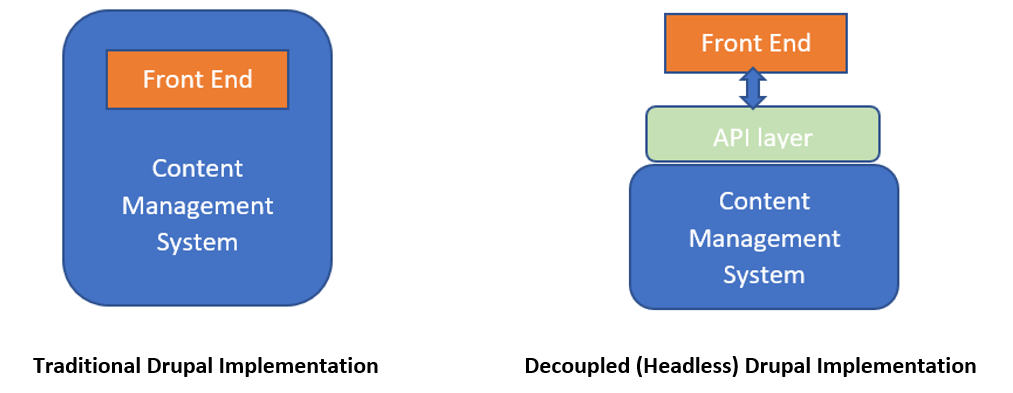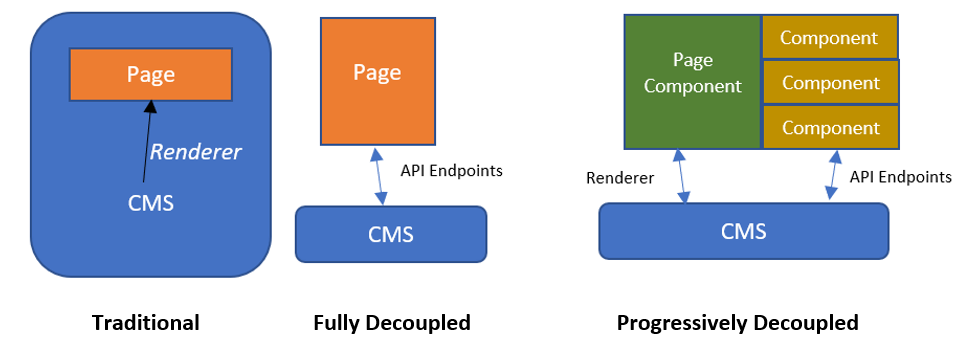With so much happening in the Drupal world, one aspect that has caught a lot of attention in recent times is the concept of decoupling the Drupal website. With so much proliferation in digital channels, this concept has caught a lot of steam recently. In this article, we explain, in an easy-to-comprehend way, the concept, the types of decoupling, advantages, challenges, and our recommendations on if and when to decouple your Drupal CMS.

What is decoupling?
In simple terms, decoupling is an architecture approach to separating the front-end of your Drupal website from the backend via an API layer.

The approach has gained massive popularity because of the flexibility it provides to content managers, backend, and front-end developers. Traditionally, both backend and frontend are built within Drupal (Figure 1). But in a decoupled approach, the frontend is separated from Drupal and is independently created/maintained. An API layer between the frontend and backend allows for interaction between the two.
In a decoupled approach, Drupal acts primarily as the content repository while any JavaScript framework or programming language can be used to build the frontend. Typically, JavaScript frameworks like React, Angular, Vue, Gatsby, or PHP frameworks like CakePHP or Laravel are used. Any frontend framework that can interact with REST APIs can be used to build the frontend in the decoupled Drupal thus giving site owners a lot of options.
Why decouple your Drupal website?
Content consumption across channels
Unlike traditional businesses, today’s brands are expected to interact with their end consumers in various different channels like a mobile app, a chatbot, voice assistants, IoT devices, digital assistants, etc. The number and types of channels to cater to are proliferating by the day. Brands need a digital architecture that allows for adapting to these scaling needs. By decoupling the Drupal frontend from the backend, we can effectively use Drupal as the master content repository which serves all the different channels that we intend to use today or in the future.
User Experience Flexibility
While you can build great user experiences leveraging Drupal as the frontend, Drupal still uses PHP which is a server-side programming framework. If your business demands that you frequently refresh the user experience of your digital assets, let us say once in a year or so, decoupling the front-end makes a lot of sense. When the need arises, the UX and UI teams can independently work on modifying and improving the user experience without disturbing or relying on any change in the Drupal architecture (backend). This provides great flexibility for the front-end and also brings down unnecessary costs of redevelopment to the backend.
Skill Availability
Another important reason why site owners choose to decouple Drupal websites is it allows them to diversify the skills needed to build and manage their Drupal website. By decoupling, we effectively can manage the frontend of the Drupal website with just frontend framework skills (like React, Angular, Vue, etc.) while the backend alone will need Drupal skills. This, again, makes sense for site owners who need a lot of UI/UX flexibility but do not wish to interfere with the core functioning of the Drupal backend and have available frontend framework skills at their disposal.
Different Types of Decoupling
There are two different ways to decouple your Drupal website.
Fully Decoupled Drupal

In a fully decoupled approach, the frontend layer is totally separated out from the backend CMS layer. While this allows UI flexibility and richness, it also takes away certain potentially beneficial content management capabilities like layout management, page building, content preview, etc. from content editors. This approach could also have performance bottlenecks due to the number of API hits that are required to serve content to the frontend.
Progressively Decoupled Drupal

In a progressively decoupled approach, we bring the best of both worlds – Drupal content management and frontend flexibility – by decoupling only those components that are needed. Essentially the page’s skeleton is still rendered within Drupal but certain interactive and UX-rich components are decoupled from Drupal within the page. This component-based implementation allows for UX/UI flexibility along with out-of-the-box Drupal’s content management and performance capabilities.
Why Drupal is a great option for Decoupling?
For beginners, Drupal (since Drupal 8) is an API-first platform. This means all the core Drupal entities – nodes, users, taxonomies, comments, etc.- are available via APIs. RESTful, REST UI, JSON: API, GraphQL, and a slew of other API-friendly modules allow for seamless integration between frontend and backend making Drupal an easy choice for headless implementations.
Challenges to keep in mind when Decoupling
While these are interesting architecture strategies to consider, it is imperative that we also analyze the challenges that come with them. Below are some of the challenges that come up when we decouple our Drupal website.
- Development and maintenance could become a little complex with two different teams – frontend and backend – being involved in the website.
- The architecture itself, if not properly built, could lead to difficulties in maintaining and scaling for the future.
- Ongoing maintenance for a fully decoupled Drupal website will require upgrades, security patches and maintenance of two separate platforms (frontend and backend).
- SEO for a decouple website could be tricky if not properly implemented.
- Out-of-the-box Drupal functionalities like layout management, account management (register, login, password reset), content preview etc. are lost in a fully decoupled approach. They have to be built and maintained on the frontend layer too which could be costly exercise.
In Summary
The approach and implementation of decoupling your Drupal website require careful planning considering all the benefits, challenges, and future use cases of both content editors and developers. When implemented systematically, we can build a highly scalable, feature-rich, and interactive Drupal website!
If you want to know more about decoupled Drupal or any concepts of your interest in Drupal or would like to discuss a challenge you are facing with your Drupal website, feel free to reach us at info@workiy.com or reach us at +1 (778) 798-0252!





